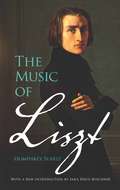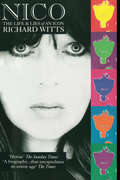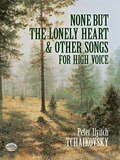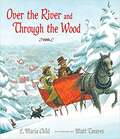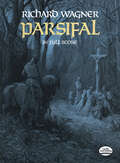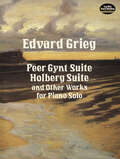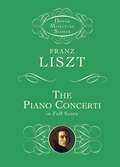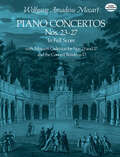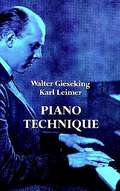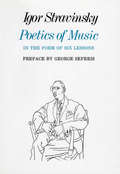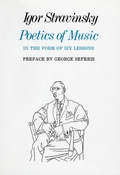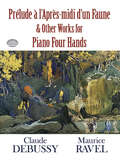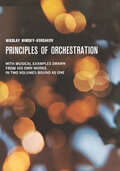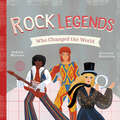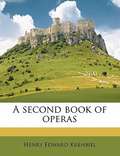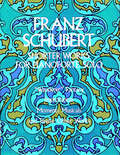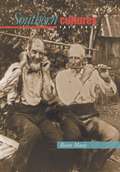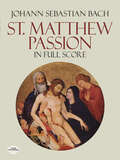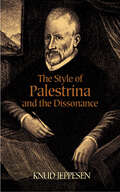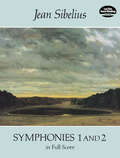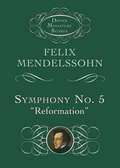- Table View
- List View
The Music of Liszt
by Humphrey Searle Sara Davis BuechnerVirtuoso pianist Franz Liszt was a key figure in the evolution of modern music. Most of his 700 compositions, which range from romantic impressionism to daring experimental pieces, were written for the piano. This survey by a well-known British composer and musicologist constitutes the most authoritative English-language study of Liszt's works. "Mr. Searle is himself a composer of progressive outlook and he thus speaks with authority. His book was needed and he has made it a good one," observed the Times (London) Literary Supplement. This classic study surveys the compositions in chronological order and the medium for which they were written. The author examines in detail the most important pieces and fully reviews Liszt's place in history. Subjects include romantic pieces, symphonic poems, songs, symphonies, and other works. A biographical summary illustrates the relationship between significant works and events in the composer's life. Acclaimed by Library Journal as "a balanced, long-overdue treatment," this study is essential for every true Lisztian student.
Nico: Life And Lies Of An Icon
by Richard WittsNico was revered as ‘the most beautiful creature who ever lived’. She was Andy Warhol’s femme fatale and the High Preistess of Weird, yet few knew her real name or her wretched origins. When she called herself ‘a Nazi anarchist junkie’, they thought she was joking.Bob Dylan wrote a song about her, Jim Morrison a poem, Jean Baudrillard an essay, Andy Warhol a film, Ernest Hemingway a story – yet she fought against the idolatry of men to assert her independence as a composer of dissident songs.Nico’s contribution as an artist (17 films and 7 LPs) was smothered by gossip of her alleged affairs with men and women, whether Jimi Hendrix or Jeanne Moreau, Brian Jones of the Rolling Stones or Coco Chanel.She drifted through society like a phantom. Each era celebrated a different Nico – the top covergirl of the Fifties, the Siren of the Sixties (as The Times acclaimed her), the Moon Goddess of the Seventies, and the High Priestess of Punk when rock stars like Siouxsie Sioux and Pattie Smith acknowledged her pre-eminence. Ironically, they did so at the lowest point in her life. For behind the Garbo-esque veneer lived a lonely woman trying to stand autonomous in a fast-changing world, seeking to survive her heroin addiction and to cope with her tormented mother and her troubled son, his existence denied by his film-star father.In this pioneer biography, which Nico asked the author to write shortly before her outlandish death in 1988, Richard Witts uncovers the reasons for her subterfuge, and examines the facts surrounding her encounters with terrorist Andreas Baader, the Black Panthers, and the Society for Cutting Up Men. Exclusive contributions from artists such as Jackson Browne, Iggy Pop, Viva, John Cale, David Bailey, Siouxsie Sioux – and many others including her relatives, friends and enemies – make this the definitive biography of an icon who was not only a testament to an era but hitherto unrecognised influence on popular music and style.
None But the Lonely Heart and Other Songs for High Voice (Dover Song Collections)
by Peter Ilyitch TchaikovskyOne of the most expressive and versatile of the great nineteenth-century Romantic composers, Peter Ilyitch Tchaikovsky brought a sense of intimacy and emotional power to all of his music — whether for orchestra, opera, ballet, or art song. Grove's Dictionary of Music and Musicians remarks on the characteristic charm of Tchaikovsky's songs, noting their "penetrating sweetness and sadness" as well as their "vocal excellence."In addition to the celebrated title work, this collection presents a rich selection of 40 enchanting melodies, including Don Juan's Serenade, Mignon's Song, Night of Stars, Serenade, Song of the Gipsy Girl, and other exquisite pieces for voice and piano. Featured texts by Goethe, Heine, Tolstoy, and other great poets appear in English and either German or French.
Over the River and Through the Wood: A Thanksgiving Poem
by Lydia Maria ChildOver the river and through the wood, To Grandfather's house we go . . . FOR NEARLY 150 YEARS the words of Lydia Maria Child's Thanksgiving poem have been as essential a part of the traditional holiday celebration as turkey and pumpkin pie.
Parsifal in Full Score
by Richard WagnerCompleted in 1882, Parsifal is Wagner's last opera and one of his finest, renowned for its splendid music and glowing orchestration. With its deeply personal treatment of the legend of the Holy Grail, and the subtle intensity and depth of compassion of its treatment of themes of innocence and purity, remorse and sexual renunciation, the opera ranks as one of Wagner's most symbolic, intense, and compassionate works.This Dover edition reproduces every note of this glorious masterpiece from the authoritative C. F. Peters edition, including the list of characters and contents in both German and English. It will be welcomed by musicians, music lovers, opera buffs, and admirers of Wagner as the only complete, inexpensive edition of a 19th-century landmark.
Peer Gynt Suite, Holberg Suite, and Other Works for Piano Solo
by Edvard GriegTreasury of piano music by great Norwegian composer, including the perennial favorites, Peer Gynt Suites Nos. 1 and 2 and the Holberg Suite, as well as a rich selection of other pieces: Vier Stucke, Op. 1, Humoresker, Op. 6, Sonata in E Minor, Op. 7, Zwei elegische Melodien, Op. 34, Stimmungen, Op. 73 and many others. Authoritative C. F. Peters edition.
The Piano Concerti
by Franz LisztOne of the greatest piano virtuosos of all time, Franz Liszt composed piano music marked by its technical brilliance, innovation, and imagination. This collection presents authoritative miniature score editions of two staples of the repertoire: Liszt's Piano Concerto No. 1 in E-flat Major and his Piano Concerto No. 2 in A Major.The works are reproduced here from authoritative editions, complete with bar-numbered movements for easy reference. Affordable, durable, and portable, this miniature score edition is ideal for study in the classroom, at home, or in the concert hall.
Piano Concertos: Nos. 23-27 in Full Score
by Wolfgang Amadeus MozartThis volume contains Mozart's last five piano concertos: No. 23 in A Major, K488; No. 24 in C Minor, K491; No. 25 in C Major, K503; No. 26 in D Major, K537; and No. 27 in B-flat Major, K595. As a bonus in the piano-plus-orchestra genre, the brief Concert Rondo in D Major, K382, has been added along with Mozart's own cadenzas for Nos. 23 and 27.The music is photographically reprinted from the Breitkopf & Härtel text, still considered the standard, authoritative edition for the Mozart concertos. Noteheads in this edition are large enough to be read easily, and margins and spaces between staves permit written notes, harmonic analysis, fingerings, and running measure numbers.Since Mozart's piano concertos are frequently performed in concert and there are several recordings currently available for each of these pieces, this edition is extremely useful for study, reference, and enjoyment.
Piano Technique
by Walter Gieseking Karl LeimerThe volume presents two book by Walter Gieseking, foremost pianist of his generation, and his teacher for five years, Karl Leimer, that have long been sought after by students and teachers looking for a radical approach toward developing not only finger-technique but expression-technique. Emphasis throughout is on listening to one's self and proper understanding as the basis of proper technique for the piano.In book one, originally titled The Shortest Way to Pianistic Perfection, Gieseking and Leimer work with a series of piano works -- a study from Lebert and Stark, Bach's Two- and Three-Part Inventions in C, and Beethoven's Sonata in F Minor, Op. 2, No. 1. Before beginning to play, the student is asked to visualize each piece through silent reading. Through Leimer's instruction in this area the student soon discovers how to approach each piece as not merely a series of notes to memorize but as a coherent musical structure to understand. Following are instructions on natural interpretation, with consideration of touch, relaxation, and proper emphasis in the practice. Also given are notes on such topics as etudes, scales, broken chords, the trill, and tranquility.In book two, Rhythmics, Dynamics, Pedal and Other Problems of Piano Playing, Leimer carries his method of visualization further with a study of the Allemande from Bach's French Suite in E Major. Following are further exercises and practices for developing other pianistic technique with reference to works of other composers. Specific exercises which cover rhythmics, dynamics, and phrasing are designed so that they will benefit not only the pianist but also performers on other instruments. Extensive chapters on variety of touch and the pedal give a great number of techniques and exercises for extending the expressive and dynamic range.
Poetics of Music
by Igor Stravinsky Arthur Knodel Ingolf DahlThese lessons provide penetrating glimpses into the thought processes of Stravinsky's mind. While dealing with his chosen topics-the phenomenon of music, the composition of music, musical typology, the avatars of Russian music, and the performance of music-he reveals his reverence for tradition, order and discipline. He believes 'the more art is controlled, limited, worked over, the more it is free. His opinions about Wagner, Verdi, Berlioz, Hindemith, Weber, Beethoven, Glinka, Tchaikovsky, Moussorgsky and Bach are refreshing. He also analyzes the function of the critic, the requirements of the interpreter, the state of Russian music, and musical taste and snobbery." - The American Recorder Once again the concertgoer and music lover can take pleasure in Igor Stravinsky's thoughts on the essentials of music. It was over thirty years ago that Stravinsky delivered the Charles Eliot Norton Lectures at Harvard University on which the French-language edition of this book and later the English translation by Arthur Knodel and Ingolf Dahl were based. Now his Poetics of Music is available in paper-with a preface by George Seferis.
Poetics of Music in the Form of Six Lessons (Charles Eliot Norton Lectures (hup) Ser. #2003)
by Igor StravinskyOne of the greatest of contemporary composers has here set down in delightfully personal fashion his general ideas about music and some accounts of his own experience as a composer. Every concert-goer and lover of music will take keen pleasure in his notes about the essential features of music, the process of musical composition, inspiration, musical types, and musical execution. Throughout the volume are to he found trenchant comments on such subjects as Wagnerism, the operas of Verdi, musical taste, musical snobbery, the influence of political ideas on Russian music under the Soviets, musical improvisation as opposed to musical construction, the nature of melody, and the function of the critic of music. Musical people of every sort will welcome this first presentation in English of an unusually interesting book.
Prelude a l'Apres-midi d'un Faune and Other Works for Piano Four Hands
by Maurice Ravel Claude DebussyHere are two suites Debussy composed specifically for piano four hands, Petite Suite and Six Épigraphes Antiques, plus Ravel's arrangement for four hands of Debussy's Prélude à l'Après-midi d'un Faune and a piano four hands version of Prélude, Cortège and Air de Danse from L'Enfant Prodigue. These works range widely in mood, displaying both the brilliant pianism at the heart of Debussy's musical imagery and the composer's affinity for the unexpected. Reprinted from authoritative French editions, these works display innovative musical qualities that will both delight and challenge pianists.
Principles of Orchestration
by Nikolai Rimsky-Korsakov"To orchestrate is to create, and this cannot be taught," wrote Nikolay Rimsky-Korsakov, the great Russian composer whose genius for brilliant, highly colored orchestration is unsurpassed. But invention, in all art, is closely allied to technique, and technique can be taught. This book, therefore, which differs from most other texts on the subject because of its tremendous wealth of musical examples and its systematic arrangement of material according to each constituent of the orchestra, will undoubtedly be of value to any music student. It is a music classic, perhaps the only book on classical orchestration written by a major composer.In it, the composer aims to provide the reader with the fundamental principles of modern orchestration from the standpoint of brilliance and imagination, and he devotes considerable space to the study of tonal resonance and orchestral combination. In his course, he demonstrates such things as how to produce a good-sounding chord of certain tone-quality, uniformly distributed; how to detach a melody from its harmonic setting; correct progression of parts; and other similar problems.The first chapter is a general review of orchestral groups, with an instrument-by-instrument breakdown and material on such technical questions as fingering, range, emission of sound, etc. There follows two chapters on melody and harmony in strings, winds, brasses, and combined groups. Chapter IV, Composition of the Orchestra, covers different ways of orchestrating the same music; effects that can be achieved with full tutti; tutti in winds, tutti pizzicato, soli in the strings, etc.; chords; progressions; and so on. The last two chapters deal with opera and include discussion of solo and choral accompaniment, instruments on stage or in the wings, technical terms, soloists (range, register, vocalization, vowels, etc.), voices in combination, and choral singing. Immediately following this text are some 330 pages of musical examples drawn from "Sheherazade," the "Antar Symphony," "Capriccio Espagnol," "Sadko," "Ivan the Terrible," "Le Coq d'Or," "Mlada," "The Tsar's Bride," and others of Rimsky-Korsakov's works. These excerpts are all referred to in the text itself, where they illustrate, far better than words, particular points of theory and actual musical practice. They are largely responsible for making this book the very special (and very useful) publication it is.This single-volume edition also includes a brief preface by the editor and extracts from Rimsky-Korsakov's 1891 draft and final versions of his own preface, as well as an appendixed chart of single tutti chords in the composer's works.
Rock Legends Who Changed the World (People Who Changed the World)
by Ashley Marie MirelesA board book tribute to music icons—from Buddy Holly to Queen—who changed rock and roll forever!
Science and Music (Dover Books On Music Ser.)
by James JeansSir James Jeans, noted British scientist, has given a physical analysis of musical sounds, in what is considered to be the best exposition on the subject, a book of great intellectual stature. His aim has been to convey precise information, in a simple non-technical way, that will be of interest to the amateur as well as the serious student of music. The discussion begins with an explanation of the development of the human faculty of hearing. It is established that each sound can be represented by a curve. An examination of the general properties of sound-curves follows. For example, why do some sounds produce pleasure when they reach our ears and some pain? How do we retain the pleasurable qualities in the sound-curve, as it passes on from one stage of electronic equipment to another? To what extent is it possible to prevent unpleasant qualities from contaminating the curve? These and other pertinent questions on the transmission and reproduction of sound-curves are answered in a discussion of tuning-forks and pure tones. The various methods of producing sound, and the qualities of the sounds produced, are further discussed as they relate to vibrations of strings and harmonics, and vibrations of air. Harmony and discord are also considered. In the final chapters on the concert room and hearing, the discussion focuses on the transmission of sound from its source to the eardrum and from the eardrum to the brain. A general theory of acoustics is also covered as well as acoustical analyses.
Shorter Works for Pianoforte Solo
by Franz SchubertSupplementing the Dover edition of Schubert's complete piano sonatas, this volume contains all of the remainder of Schubert's music for pianoforte solo (except the dances and a few unfinished pieces): the ever popular "Wanderer" fantasy, Opus 15; the 8 impromptus (Opp. 90 and 142), experimental forerunners of one of the typical genres of the later Romantic composers; the Moments Musicals, Opus 94; the Adagio and Rondo, Opus 145; and numerous variations, scherzos, and other short pieces.The music is photographically reprinted from the Breitkopf & Härtel Schubert-Gesammtausgabe, still considered the standard, authoritative edition of Schubert's music.Note heads in this edition have been reproduced in a size large enough to be read easily at the keyboard, and margins and spaces between staves are conveniently wide to permit written notes, harmonic analysis, fingerings, and running measure numbers. Essential to all classical pianists, this edition is also practical for study, reference, enjoyment -- virtually any use.
Southern Cultures: Special Roots Music Issue
by Harry L. Watson Jocelyn NealThe Special Roots Music Issue features:B.B. King on Bukka White's legacy;The Top Ten Folk Singers of All Time;Bob Dylan backstage in '63 and other rare photographic gems; Swamp bluesman Jimmy Anderson's first published interview in the U.S.; Lynyrd Skynyrd vs. the Allman Brothers; Pete, Peggy, & Mike--and all the rest that Charles Seeger gave to the world of music; Willie Lowery--musician, songwriting sensation, and humanitarian; Saxie Dowell, the great saxophonist and war hero; a sneak peek at NASHVILLE CHROME, the sizzling new novel from Rick Bass; and much more. The Roots Music Issue comes with a classic FREE CD full of great roots musicians, including BUKKA WHITE, ETTA BAKER, THE BYRDS' ROGER MCGUINN, WILLIE LOWERY, IDYLL SWORDS, ALABAMA SLIM & LITTLE FREDDIE KING, JIMMY ANDERSON & THE MOJO BLUES BAND, MICHAEL HURLEY, FILTHYBIRD, MEGAFAUN, PRESTON FULP, JOE BROWN, AND MORE OF THE SOUTH'S BEST ROOTS MUSICIANS--old and new. We'll mail the CD separately to our Roots Music e-book customers at no extra charge.Southern Cultures is published quarterly (spring, summer, fall, winter) by the University of North Carolina Press. The journal is sponsored by the University of North Carolina at Chapel Hill's Center for the Study of the American South.
St. Matthew Passion: In Full Score
by Johann Sebastian BachOne of the most performed and recorded of Bach's major works, the St. Matthew Passion has been a focal point of concert seasons and festivals around the world for over 150 years. First performed in the late 1720s, it is a drama of epic grandeur, long considered the noblest, most inspired musical treatment of the story of the crucifixion of Christ. Bach set the text, based on two chapters from the Gospel of St. Matthew, using a large ensemble of two choruses, soloists, and two orchestras. The full score is reprinted here from the fine edition prepared by the Bach-Gesellschaft.Although the St. Matthew Passion is often held to be the apotheosis of Lutheran church music, this magnificent oratorio reaches out to its audience in the language, form, and spirit of opera. Richly dramatic and theatrical, following the general form of Baroque opera, it unfolds its deeply moving story in recitatives, ariosos, arias, chorales, and mighty choral movements. This finely produced score offers music lovers the opportunity -- at a price far lower than comparable editions -- to follow performances score in hand, and to gain a more intimate knowledge of the rich musical textures of this great masterwork.
The Style of Palestrina and the Dissonance (Dover Books On Music: Analysis)
by Knud JeppesenThe greatest Renaissance creator of liturgical music, the revered sixteenth-century composer known as Palestrina wrote works that served for centuries as models of counterpoint. Until The Style of Palestrina and the Dissonance, theoreticians seldom closely analyzed the composer's work to discover its fundamental elements, including the handling of rhythm, line, and harmony.Beginning chapters discuss the standard use of rhythm and mensuration in Palestrina's time, the ecclesiastical modes, and treatment of words. Author Knud Jeppesen proceeds to explore Palestrina's music in terms of the elements that constitute his personal style, isolating unusual vertical lines and establishing common and uncommon interval skips and rhythmic accents. The heart of the book presents a modern empirical treatment of dissonance. Palestrina's contrapuntal technique forged new harmonic devices, placing dissonance on unaccented beats and highlighting text in very unorthodox ways for his time. These new uses of dissonance and resolution are explored in meticulous detail. In addition, Jeppesen includes a complete history of the evolving concept and treatment of dissonance before Palestrina, including quotations from the earliest theoretical works and numerous musical examples that illustrate the practices of Palestrina's predecessors.
Symphonies 1 and 2: In Full Score
by Jean SibeliusFinland's greatest composer and a major figure in the development of Scandinavian music, Jean Sibelius (1865-1957) is admired for his complete mastery of symphonic form. Of the seven symphonies he composed, each differs greatly from the others, for Sibelius rarely approached the symphonic "problem" the same way. Each work seems committed to the thoughts, feelings, and logic of the movement.Sibelius's first two symphonies remain among his most accessible and popular. Of all his symphonic works, perhaps the First Symphony, composed in 1898-99, adheres most to classical form yet reflects the spirit of Nordic nationalism that came to be associated with the composer's music.The Second Symphony, perhaps his most expansive and melodious work in symphonic form, demonstrates Sibelius's increasing command of orchestral form and scoring. These two major works are reprinted here from the definitive full-score editions published by Breitkopf & Härtel, Leipzig.
Symphony No. 5: "Reformation"
by Felix MendelssohnIn this staple of the orchestral repertoire, Mendelssohn interprets the Reformation in symphonic terms, building to a powerful series of variations on Martin Luther's confessional chorale, Ein feste Burg ist unser Gott (A Mighty Fortress Is Our God). This miniature score is reproduced from an authoritative edition, complete with numbered movements for easy reference. Affordable and compact, it is ideal for use in the classroom, at home, or in the concert hall.

